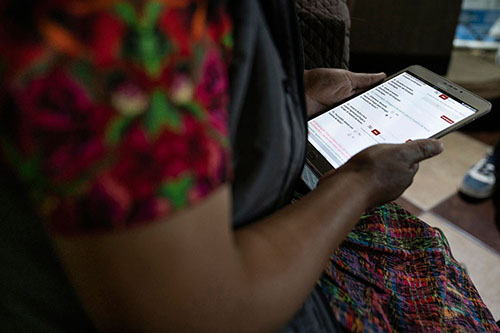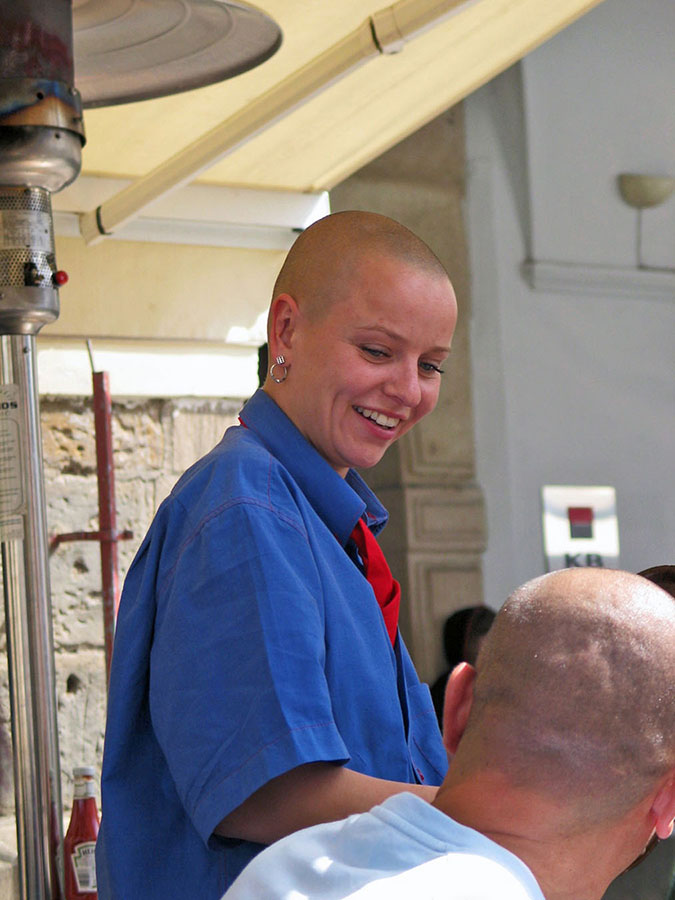2.2 Research Methods
Learning Objectives
By the end of this section, you should be able to:
- Recall the six Steps of the Scientific Method
- Differentiate between six kinds of research methods: surveys, interviews, field research, participant observations, ethnographies, and secondary data analysis.
- Explain the appropriateness of specific research approaches for specific topics.
Sociologists examine the social world, see a problem or interesting pattern, and set out to study it. They use research methods to design a study and ultimately collect data. Planning the research design is a key step in any sociological study. Sociologists generally choose from widely used methods of social investigation: primary sourced data collection such as surveys, interviews, field research, participant observations, ethnographies, and secondary data analysis. Every research method comes with plusses and minuses, and the topic of study and the theoretical paradigm a sociologist uses to think about society, strongly influences which method (or sometimes methods) are put into use. When you are conducting research think about the best way to gather or obtain data about your topic. Think of yourself as an architect. An architect needs a blueprint to build a house, as a sociologist your blueprint is your research design including your research methods.
When entering a particular social environment, a researcher must be careful. There are times when a sociologist will remain anonymous and times when their presence as a researcher is known to participants. There are times when sociologists will conduct interviews or times when they will simply observe. Some participants need to be thoroughly informed; others should not know they are being observed. A researcher wouldn’t stroll into a crime-ridden neighborhood at midnight, calling out, “Any people engaging in criminal activity around?”
Making sociologists’ presence invisible is not always realistic for other reasons. That option is not available to a researcher studying prison behaviors, early education, or the Ku Klux Klan. Researchers can’t just stroll into prisons, kindergarten classrooms, or Klan meetings and unobtrusively observe behaviors or attract attention. In situations like these, other methods are needed. Researchers choose methods that best suit their research topics, protect research participants or subjects, and that fit with their overall approaches to research.
Surveys
As a research method, surveys collect data from subjects who respond to a series of questions about behaviors and opinions, often in the form of a questionnaire or an interview. The survey is one of the most widely used sociological research methods. The standard survey format allows individuals a level of anonymity in which they can express personal ideas.
Figure 2.3 Questionnaires are a common research method. (Credit: CDC Global/flickr)
At some point, most people in the United States respond to some type of survey. The 2020 U.S. Census is an excellent example of a large-scale survey intended to gather sociological data. Since 1790, the United States has conducted a survey consisting of six questions to collect demographic data about its residents. Today, the Census consists of 12 questions and is received by residents in the United States and five territories.
Not all surveys are considered sociological research, however. Many surveys we commonly encounter focus on identifying marketing needs and strategies rather than testing a hypothesis or contributing to social science knowledge. Questions such as, “How many hot dogs do you eat in a month?” or “Were the staff helpful?” are not usually designed as scientific research. For example, the Nielsen Ratings determine the popularity of television programming through scientific market research. However, polls conducted by television programs such as American Idol, or Squid Games: The Challenge, cannot be generalized, because they are administered to a population that does not represent all television consumption, only to a specific show’s audience. You might receive similar polls through your cell phones or emails, from grocery stores, restaurants, and retail stores. They often provide incentives for completing their surveys.
Figure 2.4 Real-time surveys are common in classrooms, live-audience events, and even popular media. Twitter polls have often replaced physical devices such as the one pictured. (Credit: Sam Howzit/flickr)
Sociologists conduct surveys under controlled conditions for specific purposes. Surveys gather different types of information from people. While surveys are not great at capturing the ways people behave in social situations, they are a great method for discovering how people feel, think, and act—or at least how they say they feel, think, and act. Surveys can track preferences for presidential candidates or report individual behaviors (such as sleeping, driving, or texting habits) or information such as employment status, income, and educational levels.
A survey targets a specific population–people who are the focus of a study, such as college athletes, international students, or teenagers living with type 1 (juvenile-onset) diabetes. Most researchers choose to survey a small sector of the population, or a sample–a manageable number of subjects who represent a larger population. The success of a study depends on how well a population is represented by the sample. In a random sample, every person in a population has the same chance of being chosen for the study. As a result, a Gallup Poll, if conducted as a nationwide random sampling, should be able to provide an accurate estimate of public opinion whether it contacts 2,000 or 10,000 people.
After selecting subjects, the researcher develops a specific plan to ask questions and record responses. It is important to inform subjects of the nature and purpose of the survey upfront (i.e., informed consent). If they agree to participate, researchers thank the subjects and offer them a chance to see the results of the study if they are interested. The researcher presents the subjects with an instrument, which is a means of gathering the information.
A common instrument is a questionnaire. Subjects often answer a series of closed-ended questions. The researcher might ask yes-or-no or multiple-choice questions, allowing subjects to choose possible responses to each question. This kind of questionnaire collects quantitative data—data in numerical form that can be counted and statistically analyzed. Just count up the number of “yes” and “no” responses or correct answers, and chart them into percentages.
Questionnaires can also ask more complex questions with more complex answers—beyond “yes,” “no,” or checkbox options. These types of inquiries use open-ended questions that require short essay responses. Participants willing to take the time to write those answers might convey personal religious beliefs, political views, goals, or experiences. The answers are subjective and vary from person to person. How do you plan to use your college education?
Some topics that investigate internal processes, such as feelings of sadness, are impossible to observe directly and are difficult to discuss honestly in a public forum. People are more likely to share honest answers if they can respond to questions anonymously. This type of personal explanation is qualitative data—conveyed through words. Qualitative information is harder to organize and tabulate. The researcher will end up with a wide range of responses, some of which may be surprising. The benefit of written opinions, though, is the wealth of in-depth material that they provide.
Interviews
An interview is a one-on-one conversation between the researcher and the subject, and it is another commonly used research method. Unlike surveys, during interviews, participants are free to respond as they wish, without being limited by predetermined choices. In the back-and-forth conversation of an interview, a researcher can ask for clarification, spend more time on a subtopic, or ask additional questions. In an interview, a subject will ideally feel free to open up and answer questions that are often complex. There are no right or wrong answers. The subject might not even know how to answer the questions honestly.
Questions such as “How does society’s view of alcohol consumption influence your decision whether or not to take your first sip of alcohol?” or “Did you feel that the divorce of your parents would put a social stigma on your family?” involve so many factors that the answers are difficult to categorize. A researcher needs to avoid steering or prompting the subject to respond in a specific way; otherwise, the results will prove to be unreliable. The researcher will also benefit from gaining a subject’s trust, from empathizing or commiserating with a subject, and from listening without judgment.
Interviewers collect both quantitative and qualitative data. For example, a researcher interviewing people who are incarcerated might receive quantitative data, such as demographics – race, age, sexuality, and gender–that can be analyzed statistically. In doing so, in addition to the rich data derived from interviews, the researcher might discover that 20 percent of incarcerated people are above the age of 50. This is then analyzed alongside the qualitative data the researcher collects from incarcerated people, such as what ages of incarcerated people take advantage of educational opportunities during their sentences and other explanatory information to understand the differences and why.
The survey can be carried out online, over the phone, by mail, or face-to-face. When researchers collect data outside a laboratory, library, or workplace setting, they are conducting field research, which is our next topic.
Field Research
The work of sociology rarely happens in limited, confined spaces. Rather, sociologists go out into the world. They meet subjects where they live, work, and play. Field research refers to gathering primary data from a natural environment. To conduct field research, the sociologist must be willing to step into new environments and observe, participate, or experience those worlds. In fieldwork, the sociologists, rather than the subjects, are the ones out of their element.
The researcher interacts with or observes people and gathers data along the way. The key point in field research is that it takes place in the subject’s natural environment, whether it’s a coffee shop or tribal village, a homeless shelter or the DMV, a hospital, an airport, a mall, or a beach resort.
Figure 2.5 Sociological researchers travel across countries and cultures to interact with and observe subjects in their natural environments. (Credit: IMLS Digital Collections and Content/flickr)
While field research often begins in a specific setting, the study’s purpose is to observe specific behaviors and practices in a given setting. Fieldwork is optimal for observing how people behave. It seeks to understand why they behave that way. However, researchers may struggle to narrow down cause and effect when there are so many variables floating around in a natural environment. While field research looks for correlation, its small sample size does not allow for establishing a causal relationship between two variables. Indeed, much of the data gathered in sociology does not identify a cause and effect but a correlation.
Sociology in the Real World
Beyoncé and Lady Gaga as Sociological Subjects

Figure 2.6 Researchers have used surveys and participant observations to accumulate data on Lady Gaga and Beyonce as multifaceted performers. (Credit a: John Robert Chartlon/flickr, b: Kristopher Harris/flickr.)
Sociologists have studied Lady Gaga and Beyoncé and their impact on music, movies, social media, fan participation, and social equality. Researchers have used several research methods including secondary analysis, participant observation, and surveys from concert participants.
In their study, Click, Lee & Holiday (2013) interviewed 45 Lady Gaga fans who utilized social media to communicate with the artist. These fans viewed Lady Gaga as a mirror of themselves and a source of inspiration. Like her, they embrace not being a part of mainstream culture. Many of Lady Gaga’s fans are members of the LGBTQ community. They see the “song “Born This Way” as a rallying cry and answer her calls for “Paws Up” with a physical expression of solidarity—outstretched arms and fingers bent and curled to resemble monster claws” (Click, Lee & Holiday 2013).
Sascha Buchanan (2019) made use of participant observation to study the relationship between two fan groups, that of Beyoncé and that of Rihanna. She observed award shows sponsored by iHeartRadio, MTV EMA, and BET that pit one group against another as they competed for Best Fan Army, Biggest Fans, and FANdemonium. Buchanan argues that the media thus sustains a myth of rivalry between the two most commercially successful Black women vocal artists.
Participant Observation
In 2000, a comic writer named Rodney Rothman wanted an insider’s view of white-collar work. He slipped into the sterile, high-rise offices of a New York “dot com” agency. Every day for two weeks, he pretended to work there. His main purpose was simply to see whether anyone would notice him or challenge his presence. No one did. The receptionist greeted him. The employees smiled and said good morning. Rothman was accepted as part of the team. He even went so far as to claim a desk, inform the receptionist of his whereabouts, and attend a meeting. He published an article about his experience in The New Yorker called “My Fake Job” (2000). Later, he was discredited for allegedly fabricating some story details and The New Yorker issued an apology. However, Rothman’s entertaining article still offered fascinating descriptions of the inside workings of a “dot com” company and exemplified the lengths to which a writer, or a sociologist, will go to uncover material.
Rothman conducted a form of study called participant observation, a research method where researchers join people and participate in a group’s routine activities to observe them within that context. This method lets researchers experience a specific aspect of social life. A researcher might go to great lengths to get a firsthand look into a trend, institution, or behavior. A researcher might work as a waitress in a diner, experience houselessness for several weeks, or hang out and ride along with firefighters during their shifts. Often, these researchers try to blend in seamlessly with the population they study, and they may not disclose their true identity or purpose if they feel it would compromise the results of their research.
Figure 2.7 Is she a working waitress or a sociologist conducting a study using participant observation? A field researcher may take a job or take other steps to get firsthand knowledge of their subjects. (Credit: Gareth Williams/flickr.)
At the beginning of a field study, researchers might have a question, such as, “What really goes on in the kitchen of the most popular diner on campus?” Or, “What is it like to be houseless?” Participant observation is a useful method if the researcher wants to explore a certain environment from the inside.
Field researchers simply want to observe and learn. In such a setting, the researcher will be alert and open-minded to whatever happens, recording all observations accurately. Soon, as patterns emerge, questions will become more specific, observations will lead to hypotheses, and hypotheses will guide the researcher in analyzing data and generating results.
In a study of small towns in the United States conducted by sociological researchers John S. Lynd and Helen Merrell Lynd, the team altered their purpose as they gathered data. They initially planned to focus their study on the role of religion in U.S. towns. As they gathered observations, they realized that the effect of industrialization and urbanization was the more relevant topic of this social group. The Lynds did not change their methods, but they revised the purpose of their study. This is the power of the interpretive framework, which in turn shaped the outcome of their published results, Middletown: A Study in Modern American Culture (Lynd & Lynd, 1929).
The Lynds were upfront about their mission. The townspeople of Muncie, Indiana, knew why the researchers were in their midst. However, some sociologists prefer not to alert people to their presence. The main advantage of covert participant observation is that it allows the researcher access to authentic, natural behaviors of a group’s members. The challenge, however, is gaining access to a setting without disrupting the pattern of others’ behavior. Becoming an inside member of a group, organization, or subculture takes time and effort. Researchers must pretend to be something they are not. The process could involve role-playing, making contacts, networking, or applying for a job.
Once inside a group, some researchers spend months or even years pretending to be one of the people they are observing. However, as observers, they cannot get too involved. They must keep their purpose in mind and apply the sociological perspective. That way, they illuminate social patterns that are often unrecognized. Because information gathered during participant observation is mostly qualitative, rather than quantitative, the results are often descriptive or interpretive. The researcher might present findings in an article or book and describe what he or she witnessed and experienced.
This type of research is what journalist Barbara Ehrenreich (2001) conducted for her book, Nickel and Dimed. One day over lunch with her editor, Ehrenreich mentioned an idea: “How can people exist on minimum-wage work? How do low-income workers get by?” She wondered if someone should do a study. To her surprise, her editor responded, “Why don’t you do it?”
That’s how Ehrenreich found herself joining the ranks of the working class. For several months, she left her comfortable home and lived and worked among people who did not have, for the most part, higher educational degrees and marketable job skills. Undercover, she applied for and worked minimum wage jobs as a waitress, a cleaning woman, a nursing home aide, and a retail chain employee. During her participant observation, she used only her income from those jobs to pay for food, clothing, transportation, and shelter.
She discovered the obvious, that it’s almost impossible to get by on minimum wage work. She also experienced and observed attitudes many middle and upper-class people never think about. She witnessed firsthand the treatment of working-class employees. She saw the extreme measures people take to make ends meet and to survive. She described fellow employees who held two or three jobs, worked seven days a week, lived in cars, could not pay to treat chronic health conditions, got randomly fired, submitted to drug tests, and moved in and out of homeless shelters. She brought aspects of that life to light, describing difficult working conditions and the poor treatment that low-wage workers suffer.
The book she wrote upon her return to her real life as a well-paid writer, is widely read and used in many college classrooms today.
Figure 2.8 Field research happens in real locations. What type of environment do work spaces foster? What would a sociologist discover after blending in? (Credit: Lyncconf Games/flickr)
Ethnography
Ethnography is the immersion of the researcher in the natural setting of an entire social community to observe and experience their everyday life and culture. The heart of an ethnographic study focuses on how subjects view their social standing and how they understand themselves in relation to a socio-cultural group. As such, ethnography is the primary method used by anthropologists but is equally used by qualitative sociologists.
An ethnographic study might observe, for example, a small U.S. fishing town, a Native reservation, a village in Thailand, a Buddhist monastery, a private boarding school, or an amusement park. These places all have borders. People live, work, study, or vacation within those borders. People are there for a certain reason and therefore behave in certain ways and respect certain cultural norms. An ethnographer would commit to spending a determined amount of time studying every aspect of the chosen place, taking in as much as possible.
A sociologist studying a tribe in the Amazon might watch the way villagers go about their daily lives and then write a paper about it. To observe a spiritual retreat center, an ethnographer might sign up for a retreat and attend as a guest for an extended stay, observe and record data, and collate the material into results.
Institutional Ethnography
Institutional ethnography is an extension of basic ethnographic research principles that focuses intentionally on everyday concrete social relationships. Developed by Canadian sociologist Dorothy E. Smith (1990), institutional ethnography is often considered a feminist-inspired approach to social analysis and primarily considers women’s experiences within male-dominated societies, social institutions, and power structures. Smith’s work even challenged sociology’s exclusion of women, both academically and in the study of women’s lives (Fenstermaker, n.d.).
Historically, social science research tended to objectify women and ignore their experiences except as viewed from the male perspective. Modern feminists note that describing women, and other marginalized groups, as subordinates helps those in authority maintain their dominant positions (Social Sciences and Humanities Research Council of Canada n.d.). Smith’s three major works explored what she called “the conceptual practices of power” and are still considered seminal works in feminist theory and ethnography today (Fensternmaker n.d.).
Secondary Data Analysis
While sociologists often engage in original research studies, they also contribute knowledge to the discipline through secondary data analysis. Secondary data does not result from firsthand research collected from primary sources but rather from the completed work of other researchers or data collected by an agency or organization. Sociologists might study works written by historians, economists, teachers, or early sociologists. They might search through periodicals, newspapers, magazines, or organizational data from any period in history.
Using available information not only saves time and money but also adds depth to a study. Sociologists often interpret findings in a new way, a way that was not part of an author’s original purpose or intention. Secondary data analysis is not to be confused with a literature review, however. As learned in the previous section (2.1), a literature review is a step in the scientific method where the researcher attempts to best understand how other researchers have studied a research topic or the conclusions they have drawn in already completed research studies on the same topic. Secondary data analysis is how researchers analyze data that already exists in unique ways. Take, for example, the Census. While data from the Census already exists, sociologists can analyze it secondarily by asking sociological questions about the data. The Census alone allows us to understand the racial demographics of the United States but coupled with other social factors, we can ask what percentages of racial demographics are more likely to obtain a college degree to help us understand resources that are accessible by different groups. Or, sociologists could even study how women were encouraged to act and behave in the 1960s, by systematically analyzing movies, television shows, magazines, and situation comedies from that period. Decades from now, researchers will most likely conduct similar studies on the advent of mobile phones, the Internet, or social media.
One of the advantages of secondary data like old movies or Census data is that it is nonreactive research (or unobtrusive research), meaning that it does not involve direct contact with subjects and will not alter or influence people’s behaviors. Unlike studies requiring direct contact with people, using previously published data and other secondary sources of data does not require entering a population and the investment and risks inherent in that research process.
Using available data does have its challenges. Public records are not always easy to access. A researcher will need to do some legwork to track them down and gain access to records. To guide the search through a vast library of materials and avoid wasting time reading unrelated sources, sociologists employ content analysis, applying a systematic approach to record and value information gleaned from secondary data as they relate to the study at hand.
Also, in some cases, there is no way to verify the accuracy of existing data. It is easy to count how many drunk drivers, for example, are pulled over by the police. But how many are not? While it’s possible to discover the percentage of teenage students who drop out of high school, it might be more challenging to determine the number who return to school or get their GED later.
Another problem arises when data are unavailable in the exact form needed or do not survey the topic from the precise angle the researcher seeks. For example, the average salaries paid to professors at a public school are publicly accessible. However, these figures do not necessarily reveal how long it took each professor to reach the salary range, what their educational backgrounds are, or how long they’ve been teaching.
When conducting content analysis, it is important to consider the date of publication of an existing source and to take into account attitudes and common cultural ideals that may have influenced the research. For example, when Robert S. Lynd and Helen Merrell Lynd gathered research in the 1920s, attitudes and cultural norms were vastly different than they are now. Beliefs about gender roles, race, education, and work have changed significantly since then. At the time, the study’s purpose was to reveal insights about small U.S. communities. Today, it is an illustration of 1920s attitudes and values.






